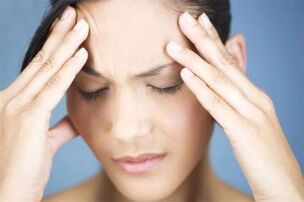Walking upright freed a person’s hands to perform work operations - that’s an undoubted plus. In addition, the load on the spine has increased, which leads to the development of serious diseases, which is a colossal minus. Osteochondrosis is one of the most common pathologies of the spine. It affects 60% of the world's population aged 35 and over. Surgical intervention is one of the methods of treatment, but it is a possible alternative in the early stages of disease development. You can treat osteochondrosis at home. The range of effective therapeutic measures is wide and affordable.
What is osteochondrosis
Dysfunction and destruction of intervertebral discs, spinal tissue is a disease of the musculoskeletal system, which is called osteochondrosis. Osteocytes are bone cells and chondrocytes are cartilage cells. Based on these names, the origin of the term "osteochondrosis" is clear. Degenerative-dystrophic changes in the spine negatively affect the general condition of the body.
As the disease progresses, the muscles atrophy, the nerve impulse conduction disorder, the physiological system and certain internal organs are damaged. The appearance of pain in the back and neck is the first sign of the disease. Depending on the location of the lesion focus, osteochondrosis is:
- Main symptoms: pain in shoulders, arms, neck; dizziness, tinnitus, spots before the eyes.
- Characterized by dull chest pain or lumbago.
- There is pain in the hip joints, lower back, sacrum. The functionality of the lower limbs is limited.
- It develops in several parts of the spine at once. He is accompanied by severe pain.
Effective treatment of osteochondrosis at home is possible with timely diagnosis of the disease. It goes through 4 stages (or phases):
- The pathological process begins with dehydration of the central part of the intervertebral disc (nucleus pulposus). As a result, the structure gives way, cracks appear on the outer part of the disc (annulus fibrosus). This phase is almost invisible to the patient. Mild discomfort is manifested in an awkward position or during active physical activity.
- The distance between adjacent vertebrae decreases due to subsidence of the intervertebral disc. Ligaments and muscles relax. The vertebrae gain extra mobility. For that reason, they were displaced. This condition is called spondylolisthesis. With a strong load, the patient feels discomfort, sometimes pain in the localization of the pathology.
- The formation of prolapses (hernias), protrusions (uneven protrusions) of discs, subluxations and arthrosis of the intervertebral joints are the main pathological changes in the third stage of the disease. The patient's movements are limited, numbness and tingling in the limbs appear. Pains are present, their localization depends on the location of the disease focus.
- To eliminate excessive mobility of the vertebrae, the body forms bone neoplasms (osteophytes) in the spine. Their formation occurs chaotically, depending on the place, they can injure the nerve endings of the spinal cord, adjacent vertebrae. Processes of pronounced structural changes (fibrous ankylosis) begin in the intervertebral joints. The vertebral-motor segment looks like a "walled up". Signs of osteochondrosis at this stage are practically not felt.
How to treat cervical osteochondrosis at home. How to provide first aid at home?
Treatment of cervical osteochondrosis at home includes:
- medicines;
- physiotherapy;
- massage;
- medical gymnastics;
- correction of the child.
The combination of therapeutic methods enables the achievement of good results in the treatment of cervical osteochondrosis. The symptoms can be very unpleasant, so you need to know how to provide first aid.
Medications
Various medications are used to combat the symptoms of the disease. They should be prescribed by a doctor who specializes in the treatment of osteochondrosis - a neuropathologist or vertebrologist.
Medications

- For severe pain, you can take a painkiller, such as metamizole sodium. If they fail, NSAIDs can be taken.
- Sometimes "distractions" are used, such as paprika. It does not heal on its own, but warms the inflamed area and relieves pain.
- Herbal infusions and diuretics are useful for edema in the area of inflammation.
The following groups of drugs are prescribed for the treatment of SHS:
- Nonsteroidal anti-inflammatory drugs (nimesulide, ketoprofen, meloxicam, diclofenac and others). It helps relieve pain, swelling and inflammation of the affected nerve root.
- B vitamins. They help to improve metabolic processes in nervous tissues.
- Chondroprotectors. Promotes cartilage tissue regeneration.
- Muscle relaxants (tizanidine, tolperisone hydrochloride). Helps reduce muscle cramps.
- Drugs aimed at improving the rheological properties of blood circulation and blood. They help improve the process of blood flow to the brain and nourish the affected nerve endings.
Intramuscular injections may also be indicated.
How to treat osteochondrosis of the cervical and thoracic spine at home. Review of home treatments
Osteochondrosis of the cervical and thoracic spine, if neglected, leads to disability. Signs of pathology:
- pain in the affected area (neck, chest) with light exertion, sudden movements;
- headaches;
- dizziness;
- shortness of breath and shortness of breath;
- fatigue.
If alarming symptoms occur, you should see a doctor for further diagnosis. If the diagnosis is confirmed, the doctor will determine the stage and prescribe treatment.
Treatment of thoracic and cervical osteochondrosis includes conservative technique and surgery. At home, you can deal with treatment in the first and second stages of development. By worsening the condition, even greater movement of the vertebrae, their fusion, the defect is removed during surgery.
Treatment of thoracic and cervical osteochondrosis at home is carried out with the help of pharmaceuticals, a complex of light physical exercises, a folk recipe for rubbing, compresses. Doctors recommend a visit to the pool, massage, physiotherapy rooms. Actions are aimed at relieving symptoms:
- muscle relaxation;
- stimulation of cartilage layers for regeneration;
- return of displaced vertebrae to their original position;
- release of pinched nerve fibers.
Home treatment of cervical and thoracic spine osteochondrosis will be effective if all the doctor's recommendations are followed.
Pharmaceutical preparations
Cervical and thoracic osteochondrosis can be treated at home with the help of medicines - usually available medicines that are easy to buy in pharmacies. Do not carry out treatment without a prescription, the wrong medicine will delay the healing process. It is impossible to predict the body's reaction to drugs. They block pain in the affected area, alleviate muscle tone, increase blood circulation, improve metabolic processes and improve well-being.
Medications slow down progression.
Medications are prescribed at home to treat thoracic and cervical osteochondrosis in the chest and neck area:
- Nonsteroidal anti-inflammatory drugs help eliminate inflammation and edema at home. After completing the course, there is a decrease in pressure on the spinal artery and blood vessels in the spinal column.
- Pain relief tablets quickly relieve pain and nervous tension.
- Relaxants - drugs that relax muscle tissue and relieve pain.
- Preparations based on chondroprotectors for osteochondrosis in the thoracic and cervical spine normalize metabolic processes in the cartilage and bone tissue of the spine. As a result, it is possible to stimulate the regenerative properties of the tissue, increase the gap between the vertebrae and allow the deformed parts to occupy the desired position. Under the influence of chondroprotectors, pain is less frequent.
- Vasodilators that improve blood flow to the site of injury. As a result of increased diet, the manifestation of symptoms is reduced, the process of correction is accelerated.
- Vitamins are useful helpers in treating osteochondrosis at home. Reception of groups B, C, E provides the body with the substances necessary for the fight. They stimulate the healing of cartilage tissue, strengthen the spine and improve the permeability of nerve fibers.
How to treat osteochondrosis and myositis at home. The main goals of home treatment
The doctor decides to treat cervical osteochondrosis at home if the patient has no serious disorders, symptoms are moderate and there are no indications for hospitalization. Selected tactics of therapy are aimed at eliminating the unpleasant manifestations of the pathological process and solving the following tasks:
- Normalization of blood circulation in the affected area.
- Elimination of brain hypoxia.
- Sleep normalization.
- Prevention of rapid disease development.
- Improved blood circulation.
- Initiation of a regeneration process to restore cartilage tissue.
- Saturation of the body with vitamins and minerals.
- Eliminate anxiety, panic attacks, irritability.
- Improve the condition of the cervical ridge.
It is completely impossible to cure chondrosis, but the right approach can significantly slow down the process, restore normal health and maintain a high quality of life for many years. An integrated approach is used for this, which involves changing the diet, increasing physical activity, taking medication and visiting a massage therapist.
Cervical osteochondrosis can be cured at home only by strictly following all the doctor's recommendations, constant monitoring of diet and medication, and conducting prescribed therapeutic exercises.
It is worth starting to treat cervical chondrosis by removing the pain. For that, the specialist chooses the appropriate pain relievers. The pharmaceutical industry offers a wide range of products that differ in principle of action, form and price. With acute unbearable pain, novocaine blockade is possible. After the main symptomatology subsides, alternative techniques can be used. It can be:
- Massage procedures - remove cramps, pain and tension.
- Exercise therapy - strengthens muscle tissue, restores normal spine support and restores its flexibility.
- Mud baths - warm the affected area and alleviate the pain syndrome for a long time.
- Manual therapy - restores metabolic processes and improves blood flow, eliminates oxygen starvation of the brain.
- Reflex massage - reduces pain in the area, begins the processes of regeneration in cartilage tissue.
- Acupuncture - activates metabolism, improves the condition of cartilage tissue, reduces the manifestation of painful feelings in the affected area.
The most affordable methods of treatment at home are ointments, rubs, baths, decoctions, compresses. Such traditional medicines have been known for a long time and are known for their safety, ease of use and minimal number of contraindications.
How to treat osteochondrosis of the cervical spine at home. Symptoms of the disease
Osteochondrosis of the cervical spine in the initial stage may not manifest itself in any way. Accompanying signs appear only in the case of an advanced form of pathology, when there is a violation of blood circulation in the brain. This process is usually followed by:
- dizziness;
- numbness of limbs;
- cold hands and feet;
- "goose" in eyes, darkening;
- headaches;
- noise in the head, ringing in the ears;
- increased fatigue;
- irritability;
- lack of coordination;
- insecurity in gait;
- tingling, tingling in the neck muscles.

If the disease takes a chronic form, then discomfort and pain constantly accompany the patient. Main events:
- painful sensations in the back of the head, neck, shoulders, arms, difficulty moving the head, crunching when turning the head or bending;
- withdrawal pain in the chest area on the left side with irradiation on the left arm, burning sensation between the shoulder blades;
- frequent headaches, increased fatigue, weakness, difficulty turning the head;
- neck pain spreads to shoulder and arm, numbness in fingers;
- may cause hearing and vision impairment, numbness of the tongue and face, dizziness, impaired lung and heart function.
Symptoms are divided into three groups:
- neurological manifestations (permanent pain in the neck, pain in the muscles, chest, joints);
- pathological effects on the spinal cord (weakness of the arms and legs, involuntary twitching, myelopathy);
- associated with processes occurring in the brain (cerebral manifestations due to insufficient blood supply: visual disturbances, foreign body sensation in the throat, noise and ringing in the ears, hearing loss, dizziness, gait instability, fainting, fatigue, irritability, disordersleep, decreased memory ability).





































